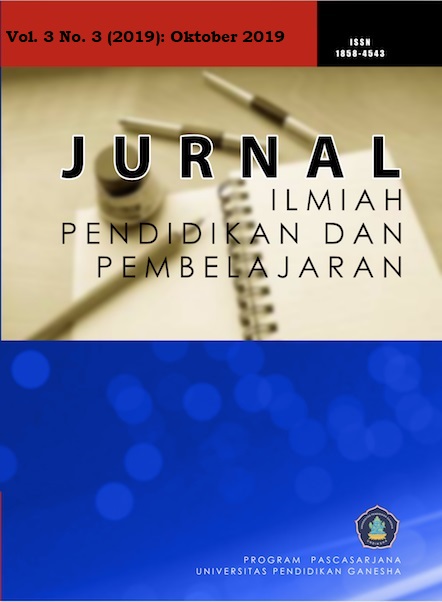Pengembangan Media Pembelajaran Berbasis Animated Demonstration pada Mata Pelajaran Komputer dan Jaringan Dasar
DOI:
https://doi.org/10.23887/jipp.v3i3.21845Abstrak
Artikel ini membahas tentang perancangan pengembangan media pembelajaran berbasis animated demonstration pada mata pelajaran komputer dan jaringan dasar di sekolah menengah kejuruan (smk). Media pembelajaran yang dirancang berisi materi sejarah komputer dan komponen-komponen komputer beserta animasi perancangan jaringan komputer yang bersifat abstrak dan tidak bisa dilihat secara kasat mata. Materi tersebut digambarkan secara nyata dan mudah dipahami oleh perserta didik. Metode yang digunakan dalam pengembangan media pemebelajaran adalah R&D (research and development). Pengembangan media pembelajaran menggunakan proses 4D (four-D) dengan Use case diagram, flowchart dan selanjutnya dikembangkan menggunakan tool Adobe Flash cs6. Hasil penelitian menunjukkan bahwa media pembelajaran komputer dan jaringan dasar mudah digunakan bagi peserta didik dan guru dalam proses pembelajaran.
Kata kunci: Media Pembelajaran, Jaringan Dasar, Komputer
Referensi
Fletcher, J. D. & Rockway, M. R. 1986. Training devices: Concepts and progress. In J. A. Ellis (Ed.), Military contributions to instructional technology (pp.717-222). New York, NY: Praeger.
Gordonov, Anatoliy et al. 1997. Video Network in an Electronic Classroom Environment and Analysis of Student Preferences in the Development of a Network-Based Video Distribution System. ASCUE Proceeding and Journal of Educational Resources Information Center. P. 79-80.
Jendral, D., Riset, K., & Tinggi, P. 2015. KERANGKA KUALIFIKASI NASIONAL INDONESIA Dokumen 001, 1–9.
Kneale, Bruce et al. 2004. VELNET (Virtual Environtment for Learning Networking. The 6th Australasian Computing Education Conference (ACE2004), Dunedin, New Zealand. Vol. 30, p. 1-8.
Lee, J., Kao, H., & Yang, S. 2014. Service innovation and smart analytics for Industry 4 . 0 and big data environment. Procedia CIRP, 16, 3–8.
Lowe, J. 2001. Computer-based education: Is it a panacea?. Journal of Research on Technology in Education, 34(2), 163-171.
Patwardhan, Mrinal & Murthy, Sahana. 2017. Designing Reciprocative Dynamic Linking to Improve Learners’ Representational Competence in Interactive Learning Environments. Journal of Research and Practice in Technology Enhanced Learning. Vol. 12, Issue 10, p. 1-30.
Perez, Rafael Garcia. 2016. Virtual Empathy as Digital Competence in Education 3.0. International Journal of Educational technology in Higher Education. Vol 13, Issue 20, p. 1-10.
Shlechter, T. M. 1991. Problems and promises of computer-based training. Norwood, NJ: Ablex.
Trianto. 2012. Mendesain Model Pembelajaran Inovatif-Progresif. Jakarta: Kencana Predana Media Group
Vojtovič, S., Navickas, V., & Gruzauskas, V. 2016. JOURNAL OF SECURITY AND SUSTAINABILITY ISSUES ISSN 2029-7017 print / ISSN 2029-7025 online 2015 March Volume 4 Number 3. Journal of Security and Sustainability Issues, 5(2), 489–499. https://doi.org/10.9770/jssi.2016.5.3(4)
Unduhan
Diterbitkan
Cara Mengutip
Terbitan
Bagian
Lisensi
Authors who publish with the Jurnal Ilmiah Pendidikan dan Pembelajaran (JIPP) agree to the following terms:
- Authors retain copyright and grant the journal the right of first publication with the work simultaneously licensed under a Creative Commons Attribution License (CC BY-SA 4.0) that allows others to share the work with an acknowledgment of the work's authorship and initial publication in this journal.
- Authors are able to enter into separate, additional contractual arrangements for the non-exclusive distribution of the journal's published version of the work (e.g., post it to an institutional repository or publish it in a book), with an acknowledgment of its initial publication in this journal.
- Authors are permitted and encouraged to post their work online (e.g., in institutional repositories or on their website) prior to and during the submission process, as it can lead to productive exchanges, as well as earlier and greater citation of published work. (See The Effect of Open Access)










